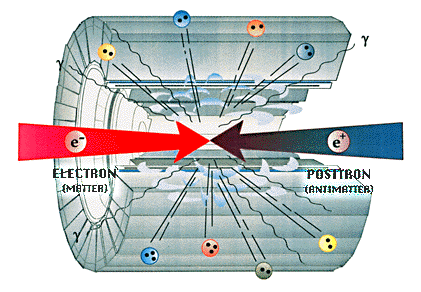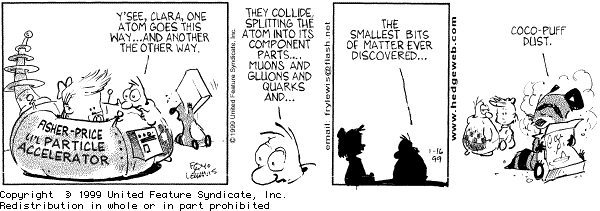
One of the most significant branches of contemporary physics is the study of the fundamental subatomic constituents of matter, the elementary particles. This field, also called high-energy physics, emerged in the 1930s out of the developing experimental areas of nuclear and cosmic-ray physics. Initially investigators studied cosmic rays, the very-high-energy extraterrestrial radiations that fall upon the Earth and interact in the atmosphere (see below The methodology of physics). However, after World War II, scientists gradually began using high-energy particle accelerators to provide subatomic particles for study. Quantum field theory, a generalization of QED to other types of force fields, is essential for the analysis of high-energy physics.

During recent decades a coherent picture has evolved of the underlying strata of matter involving three types of particles called leptons, quarks, and field quanta, for whose existence evidence is good. (Other types of particles have been hypothesized but have not yet been detected.) Subatomic particles cannot be visualized as tiny analogues of ordinary material objects such as billiard balls, for they have properties that appear contradictory from the classical viewpoint. That is to say, while they possess charge, spin, mass, magnetism, and other complex characteristics, they are nonetheless regarded as pointlike. Leptons and quarks occur in pairs (e.g., one lepton pair consists of the electron and the neutrino). Each quark and each lepton have an antiparticle with properties that mirror those of its partner (the antiparticle of the negatively charged electron is the positive electron, or positron; that of the neutrino is the antineutrino). In addition to their electric and magnetic properties, quarks have very strong nuclear forces and also participate in the weak nuclear interaction, while leptons take part in only the weak interaction.
Ordinary matter consists of electrons surrounding the nucleus, which is composed of neutrons and protons, each of which is believed to contain three quarks. Quarks have charges that are either positive two-thirds or negative one-third of the electron's charge, while antiquarks have the opposite charges. Mesons, responsible for the nuclear binding force, are composed of one quark and one antiquark. In addition to the particles in ordinary matter and their antiparticles, which are referred to as first-generation, there are probably two or more additional generations of quarks and leptons, more massive than the first. Evidence exists at present for the second generation and all but one quark of the third, namely the t (or top) quark, which may be so massive that a new higher-energy accelerator may be needed to produce it.
The quantum fields through which quarks and leptons interact with each other and with themselves consist of particle-like objects called quanta (from which quantum mechanics derives its name). The first known quanta were those of the electromagnetic field; they are also called photons because light consists of them. A modern unified theory of weak and electromagnetic interactions, known as the electroweak theory, proposes that the weak nuclear interaction involves the exchange of particles about 100 times as massive as protons. These massive quanta have been observed--namely, two charged particles, W+ and W-, and a neutral one, Zo.
In the theory of strong nuclear interactions known as quantum chromodynamics (QCD), eight quanta, called gluons, bind quarks to form protons and neutrons and also bind quarks to antiquarks to form mesons, the force itself being dubbed the "color force." (This unusual use of the term color is a somewhat forced analogue of ordinary color mixing.) Quarks are said to come in three colors--red, blue, and green. (The opposites of these imaginary colors, minus-red, minus-blue, and minus-green, are ascribed to antiquarks.) Only certain color combinations, namely color-neutral, or "white" (i.e., equal mixtures of the above colors cancel out one another, resulting in no net color), are conjectured to exist in nature in an observable form. The gluons and quarks themselves, being colored, are permanently confined (deeply bound within the particles of which they are a part), while the color-neutral composites such as protons can be directly observed. One consequence of color confinement is that the observable particles are either electrically neutral or have charges that are integral multiples of the charge of the electron. A number of specific predictions of QCD have been experimentally tested and found correct.

Excerpt from the Encyclopedia Britannica without permission.